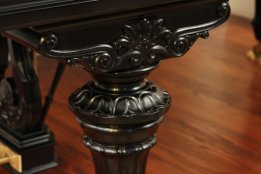
A piano can be partially or completely restored depending on the customer’s preference and the sequence of restoration.
Please contact me for information about partial piano rebuilding.
In general, there are three main aspects of any complete piano rebuilding:
- action rebuilding,
- interior rebuilding,
- refinishing.
Restoring the action:
The action is the “engine” of the piano. If it is is worn out it is not possible to achieve musical satisfaction while playing an instrument with such action.
Usually, during the process of piano action restoration, all the action parts have to be replaced – including hammers, shanks with flanges, whippens, backchecks, etc.
There are constant debates among piano technicians, factories and showrooms, what the best parts are to use.
I strongly believe, currently the genuine Hamburg Steinway and some vintage spec. Renner action parts are the best for any Steinway grand piano and for Bösendorfer, Bechstein or Mason & Hamlin the parts made by Renner specially dedicated for those pianos. Since this is the choice of most of the fine concert pianists throughout the entire world.
I am almost always exclusively using those Hamburg Steinway or Renner parts unless the customer requests otherwise.
Be aware that the different combinations of hammers, shanks and whippens installed will effect the not only the “new” touch but the “new” sound of the piano, as well. O it is essential not only get those fine parts but use the right combination of them.
Most of these Hamburg Steinway and Renner piano parts that I use are not available in the US because of certain reasons, but even if they were, technicians don’t know how to work with them. This is especially obvious when it comes to voicing those hammers. However as a result of my background I did receive the proper training and have the decades long experience with these parts.
Interior restoration:
As a result of a proper interior restoration, the piano can regain its original musical qualities and structural strength.
After many decades of being exposed to humidity and dryness, the inside parts of the piano are loosing their original strength, musical properties and their beauty, as well. Even structural elements can be damaged. That means that the strings can get rusty – they loose their clear tone and shine. The soundboard and the bridges can crack, causing sympathetic vibration and the tone can loose its depth.
Once the pinblock becomes loose or cracked, doesn’t hold the tuning pins in place, the piano becomes “untunable”.
During interior rebuilding the piano receives new pinblock, usually a new soundboard – or in some cases the original board gets repaired (see more later on this subject) -, new strings, new tuning pins, the plate gets re-bronzed. One of the most important things during a rebuilding process is to set the down-bearing right.
We do more than most of the rebuilders. Including changing agraffes if desired, using special varnish on the soundboards to ensure a superior sound and protection.
Refinishing:
– using lacquer:
With time, the cabinet of the piano may lose its luster and original beauty, therefore the original finish has to be completely removed. The veneer and the wood work has to be repaired, then stained to the requested color (shade) and then all the surfaces can be sprayed, first with sealer, and then many layers of lacquer. After several weeks of drying, the piano can be hand-rubbed.
– using shellac:
As part of my original training over two decades ago, as an apprentice, I also had to learn how to refinish a piano completely with shellac, in color or in ebony, either in high gloss or satin. From the 16th to the end of the 19th century fine furniture, as well as pianos, were refinished with such technique. I have references and additional information so upon your request I can provide them.


